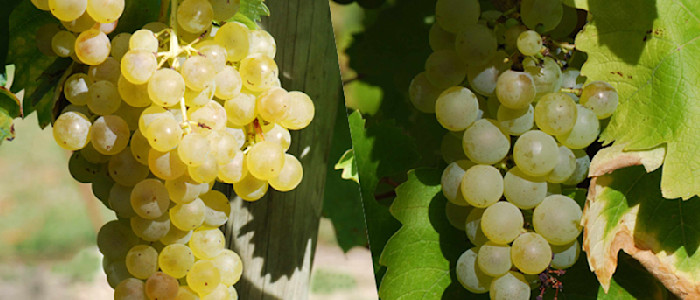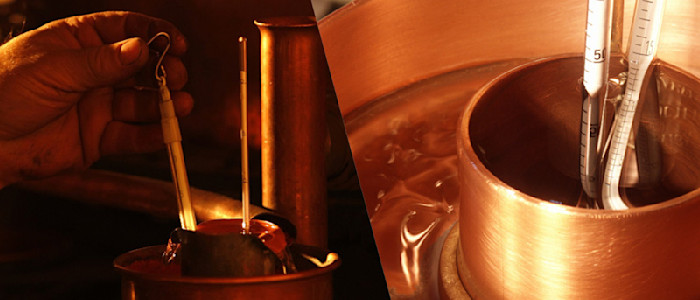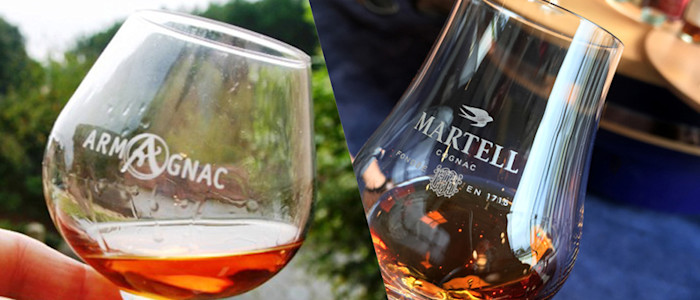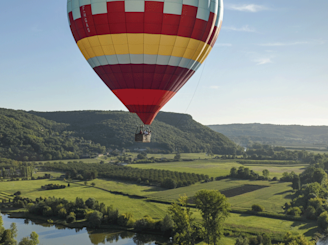Let’s take a look at their similarities and particularities, because between these two spirits, there’s no flavour battle. Armagnac Vs Cognac: why choose?
1. Terroir

The first difference between Cognac and Armagnac: terroir.
The Cognac and Armagnac terroirs, both in the Nouvelle-Aquitaine region, are located some 300 km from each other; which means differences in the soil.
Armagnac vines grow in fine quartz sands, continental and riverbed sediments and siliceous clay. This terroir is divided into 3 crus:
- Bas-Armagnac or Black Armagnac is partially located in the Landes area. It is characterized by siliceous clay land which is poor in limestone and occasionally acid.
- Haut-Armagnac or White Armagnac is characterized by soils which are predominantly limestone except along its southern part where soils are siliceous clay “boulbènes” (bolbena in Occitan).
- Ténarèze is transitional land which is partially situated in Lot et Garonne. Here, vines are grown on soils which are predominantly clay-limestone.
Map of Armagnac crus
Cognac soils are mainly limestone. Cognac is divided into 6 crus:
- Grande Champagne, around the town of Segonzac, produces the finest Cognac eaux-de-vie.
- Petite Champagne, sits astride the Charente and Charente-Maritime departments, around Barbezieux (Charente), Archiac and Jonzac (Charente-Maritime).
- Borderies, a small production area around the village of Burie.
- Fins Bois is located on the periphery of the three aforementioned areas. It is here that the majority of the wines are produced (42%).
- Bons Bois, further yet from Cognac.
- Bois Ordinaires. In this extensive area only 1.5% of vines are devoted to Cognac. They are found close to the Atlantic Ocean as well as Deux-Sevres and Dordogne.
Map of Cognac crus
2. Grape varieties

In Cognac 97% of the grape variety used is Ugni-Blanc which produces fine, high-quality eaux-de-vie. It is also used in Armagnac (55%).
In Armagnac, we also find Folle Blanche (2%) which produces fine, floral eaux-de-vie, Colombard with fruity, spicy aromas enjoyed in blends, Baco (hybrid of Folle Blanche and the American Noah) which produces well-rounded eaux-de-vie with a ripe fruity aroma (35%).
The differences in the use of the grape varieties in these two regions come from the fact that Armagnac produces wine intended for consumption without being distilled. This is not the case in Cognac where the highly-acid wine is not pleasant if left unaltered.
3. The distilling and ageing method

Most Armagnac is obtained using the Armagnac continuous still. The patent for this equipment was filed in 1818 and perfected over time by distillers. The eau-de-vie obtained at the end of the distilling process has an alcohol content of 52% to 72%.
Distilling with the Charente still, however, requires two distillations. The first heating cycle results in a 20 to 30% degree alcohol called “brouillis” which will be redistilled during the second cycle known as “bonne chauffe” at 70-71 degrees. This last distillation will become Cognac.
A similarity is that labels on Cognac and Armagnac bear the same references attesting to the number of years of ageing:
- VS Very Special: young, aged for 2 years at least
- VSOP Very Superior Old Pale : aged for 4 years at least
- XO Extra Old : aged for 10 years at least
- Millésime: from a single harvest (a reference vintage year)
4. Commercialization

Armagnac: a family-sized production and French consumption
As we already mentioned, Armagnac is one of the oldest eaux-de-vie. Its history is an integral part of French gastronomic heritage as illustrated in the many recipes and culinary preparations which include Armagnac (for flaming, sauces, etc.). However, Armagnac is but little exported and continues to be mainly consumed in France. It comes from small producers and family-run establishments which perpetuate ancestral traditions and know-how.
Cognac: great Cognac houses which export worldwide
Unlike Armagnac, Cognac historically developed focusing on export to the Netherlands and to England. Cognac was created by wine producers who wished to export their low-alcohol white wine to England and Holland but decided to distill it so it would better withstand the journey.
Its success in Holland is the result of its ageing in oak barrels. The resulting eau-de-vie was nicknamed “brandewijn” (burnt wine), which would become “brandy”.
The existence of the port of La Rochelle and the 1860 Trade Agreement between France and England under the authority of Napoleon III enabled Cognac to grow exponentially abroad, which continues to this day. 98% of the production is exported. Cognac is mainly sold by __four major, world-known Cognac trading houses: Hennessy, Courvoisier, Remy-Martin and Martell.
Cognac has now become an absolute trend in the United States. After “Pass the Courvoisier” Busta Rhimes’ hit, in 2012 the performer Jay-Z entered into a partnership with Bacardi to create his own brand of Cognac: D’Ussé.
In China, it is not uncommon to enjoy it during the meal or in a karaoke bar. In recent years, new markets have emerged such as South Africa and Oceania.
Did you know?
Discover the Armagnac ecomuseum 30 minutes from Mont-de-Marsan, in Labastide-d’Armagnac. Visit the museums dedicated to wine producers and stills set in the heart of an Armagnac-producing estate. The site also offers a nature trail.
Armagnac ecomuseum
20 kilometres from Cognac, visit the Cognac ecomuseum located on the Domaine de Tesseron. It presents the Tesseron family history and heritage through its Winemaker-Distiller Museum as well as the world of Cognac in a fun-filled, poetic way.
Cognac ecomuseum
(Warming : Alcohol abuse is dangerous for your health)





